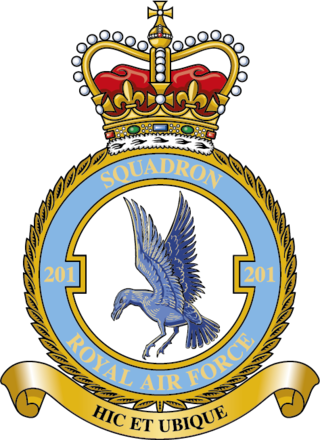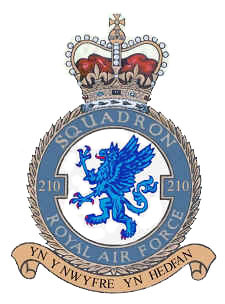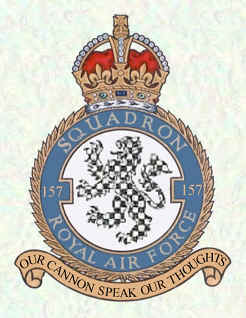
No. 206 Squadron is a Test and Evaluation Squadron of the Royal Air Force. Until 2005 it was employed in the maritime patrol role with the Nimrod MR.2 at RAF Kinloss, Moray. It was announced in December 2004 that 206 Squadron would disband on 1 April 2005, with half of its crews being redistributed to Nos. 120 and 201 Squadrons, also stationed at Kinloss. This was a part of the UK Defence Review called Delivering Security in a Changing World; the Nimrod MR.2 fleet was reduced in number from 21 to 16 as a consequence.

Number 201 Squadron is a squadron of the Royal Air Force. It currently operates the Boeing Poseidon MRA1 from RAF Lossiemouth, Moray.

Number 230 Squadron Royal Air Force is a Royal Air Force (RAF) flying squadron, currently based at Medicina Lines in Brunei Darussalam, part of British Forces Brunei, operating the Westland Puma HC2. The squadron was previously part of Royal Air Force Germany (RAFG), operating the Puma HC1 there from 1980. Following the drawdown of the British Armed Forces in Germany at the end of the Cold War, the squadron disbanded on 30 April 1992. This was short-lived however, and the squadron reformed at RAF Aldergrove on 4 May 1992, again with the Puma HC1.
No. 515 Squadron RAF was a squadron of the Royal Air Force formed during the Second World War. It ushered in Electronic countermeasures (ECM) warfare, jamming enemy radar installations from October 1942 as the only such squadron in the RAF initially. Later in the war 515 Sqn was joined by other squadrons as part of No. 100 Group RAF. The squadron disbanded after VE day, when the need for such a specialised squadron had reduced.
No. 695 Squadron RAF was an anti-aircraft co-operation squadron of the Royal Air Force from 1943 to 1949.
No. 679 Squadron RAF was an anti-aircraft co-operation squadron of the Royal Air Force during the Second World War.

No. 461 Squadron was a Royal Australian Air Force maritime patrol squadron during World War II which operated under Royal Air Force control flying in Europe and over the Atlantic. The squadron was formed in 1942 and was disbanded in mid-1945, just after the end of the war in Europe. Personnel were drawn from many countries of the British Empire, although the majority were Australians. Throughout the war, the squadron was credited with destroying a total of six German U-boats, and operated mainly in the Bay of Biscay and Atlantic.
No. 598 Squadron RAF was an Anti-aircraft Co-operation squadron of the Royal Air Force during the Second World War.

Number 207 Squadron is a historic bomber squadron and, latterly, a communications and flying training squadron of the Royal Air Force. It was announced on 5 July 2017 that No. 207 Squadron will again reform to become the Operational Conversion Unit for the UK F-35B Lightning Force and will return to RAF Marham in Norfolk where it was last based in 1965. No. 207 Squadron arrived at RAF Marham with six F-35Bs on 16 July 2019 before officially standing up on 1 August.

No. 210 Squadron was a Royal Air Force unit established in the First World War. Disbanded and reformed a number of times in the ensuing years, it operated as a fighter squadron during the First World War and as a maritime patrol squadron during the Spanish Civil War, the Second World War and the Cold War before it was last deactivated in 1971.
No. 158 Squadron RAF was a World War I proposed ground attack squadron that did not become operational in time to see action, and a World War II bomber squadron. After World War II had ended in Europe the squadron operated in the transport role until disbandment in December 1945.
No. 228 Squadron RAF was a squadron of the Royal Air Force active at various times between 1918 and 1964. It spent the greatest part of its existence flying over water, doing so in the First, and Second World Wars and beyond, performing anti-submarine, reconnaissance and air-sea rescue tasks.
No. 169 Squadron RAF was a tactical reconnaissance and later a night intruder squadron of the Royal Air Force during World War II.
No. 521 Squadron of the Royal Air Force was a Second World War meteorological observation unit operating from Norfolk.
No 295 Squadron RAF was an airborne forces and transport squadron of the Royal Air Force during World War II. It was the first unit to be equipped with the Armstrong Whitworth Albemarle transport and glider tug aircraft.
No. 137 Squadron RAF existed briefly as a day bomber unit in World War I but never became operational. During World War II it flew as one of the two Whirlwind squadrons before converting to Hurricane Mk.IV fighter-bombers and later the Hawker Typhoon in the same role. The squadron was disbanded in August 1945.
No. 292 Squadron RAF was an air-sea rescue (ASR) squadron of the Royal Air Force operating in the Bay of Bengal during the Second World War.
No. 240 Squadron RAF was a Royal Air Force flying boat and seaplane squadron during World War I, World War II and up to 1959. It was then reformed as a strategic missile squadron, serving thus till 1963.

No 279 Squadron RAF was a Royal Air Force air-sea rescue squadron of World War II. The squadron was formed on 16 November 1941 and disbanded on 10 March 1946.

No. 157 Squadron RAF was a Royal Air Force Squadron active as a night fighter unit in the Second World War.








